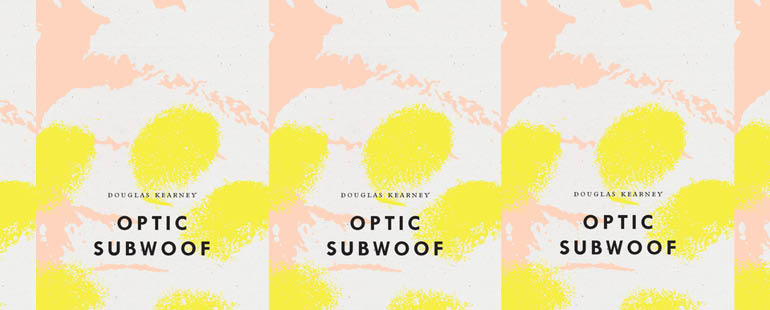The Peculiar Ritual of Poetry Readings in Douglas Kearney’s Optic Subwoof

Optic Subwoof
Douglas Kearney
Wave Books | November 15, 2022
Optic Subwoof gathers the lectures Douglas Kearney gave during 2020 and 2021, mainly over Zoom, for the Bagley Wright Lecture Series, “a nonprofit that supports contemporary poets as they explore in-depth their own thinking on poetry and poetics,” according to its website. Unusually for books on poetry and poetics, Optic Subwoof devotes considerable space and intellectual power to the topic of poetry readings—those familiar, typically subdued performances that regularly occur in any American city with one or more MFA programs. Besides the book’s other virtues, its final chapter (“I Killed, I Died: Banter, Self-Destruction, and the Poetry Reading”) is the most interesting take I have ever read—I may as well say the only interesting take I have ever read—on the modern poetry reading, that peculiar ritual in which the poet is both the priest and the sacrifice.
It makes sense that Kearney would open a conversation on the “poetry reading” as practice and institution, as he is himself an unforgettable performer of his own poetry. (The reader can, and should, verify this statement by a visit to YouTube.) Kearney’s readings foreground not only his voice, which can shape-shift its volume, pitch, and inflection in an eyeblink, but also his body; he describes lying down on the floor to show how James Byrd, Jr. was dragged behind a truck in Texas, and opening a poem called “Runaway Tongue” by literally running away, smack into a “wall of concrete masonry laid in a stack bond pattern” at the University of Arizona Poetry Center.
The reader may insert their own joke about slam poetry here, but while such vocal and bodily acrobatics may remind one of slam, Kearney’s performances have little to do with the staged subjecthood or emotionalism of that scene. Instead, think Marina Abramovic, or the heady early days of Dada at the Cabaret Voltaire. One could consult Fred Moten’s In the Break or Saidiya Hartman’s Scenes of Subjection to find the most immediate and relevant aesthetic context for Kearney, a Black artist living in the United States, but at the same time he conjures Hugo Ball, Kurt Schwitters, and Max Ernst.
Ernst particularly came to mind as I read the book’s first lecture, “You Better Hush: Blacktracking a Visual Poetics” and its brilliant discussion of collage: “Disruption is a fact of collage. Whether we speak of the hole cut in one context as a part of its decontextualization or our recognition of recontextualization on the other end of the procedure, something is where it wasn’t and is doing some new work where it is now.” Schwitters and Ball came to my mind as Kearney described his “Loud-Assed Colored Silence” poems and their “dintelligibility,” Kearney’s term for “a phenomenon where what appears as noise in noise to some…is in fact complex contrapuntal signals resulting in ‘legible noise.’” A kind of concrete poetry crossed with the digital sampling of hip-hop, “Loud-Assed Colored Silence” poems live simultaneously on both sides of the border between the seen and the heard, making the visible audible, the audible visible: an optical subwoof indeed. Their name perhaps alludes to Noam Chomsky’s famous example of the nonsensical—“Colorless green ideas sleep furiously”—in order to answer it, asserting a meaning that breaks out of the apparently meaningless.
Kearney does not seek to bewilder for the sake of bewilderment any more than the original Dadaists did. As they attacked the institution of “art” for its complicity in the butchery of the First World War, Kearney’s prose and poetry are mindful interventions in a society that seems capable of any kind of violence in support of a racism whose existence it denies. The book’s third lecture, “Red/Read, Read/Red: Putting Violence Down in Poetry” surveys that theme not only in Kearney’s own but in a generous sampling of other poets; the essay amounts to a micro-anthology on this theme. Racially motivated violence and its history also have a part in Kearney’s performance at his readings; the running away at the beginning of “Runaway Tongue” alludes to slavery. Kearney quotes Amaud Jamaul Johnson: “What does it mean when we’re triggered by our own work?”
“When I am at a poetry reading,” Kearney writes, “I feel like the bear and the person there to wrestle it.” Kearney takes the question of reading-as-performance in an even more surprising direction in the lecture “#Werewolfgoals.” After describing several memorable cinematic transformations, Kearney wonders whether part of the audience is expecting Kearney, at the podium, to turn into something scary. And maybe he will.
One hesitates to call any aspect of contemporary poetic practice under-theorized, but by looking hard at the institution of the poetry reading, Kearney has gone where others should follow. What he says about “banter” —the sometimes brief, sometimes expansive remarks the poet makes before reading the poem—is worth a symposium all by itself. And what he says about race, violence, and poetry reminds us that the Bagley Wright Lecture Series is one to keep an eye on.



